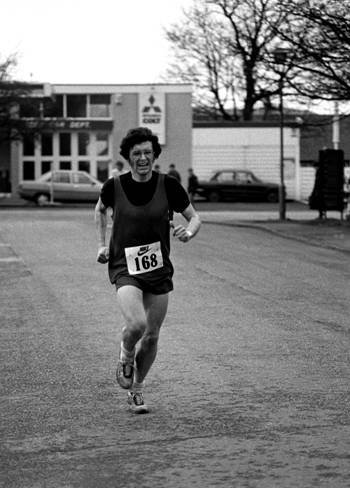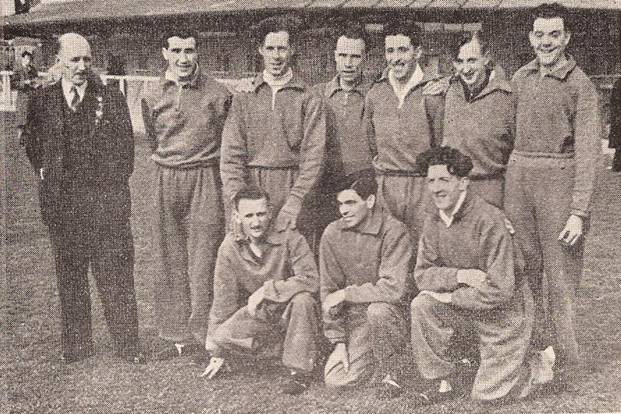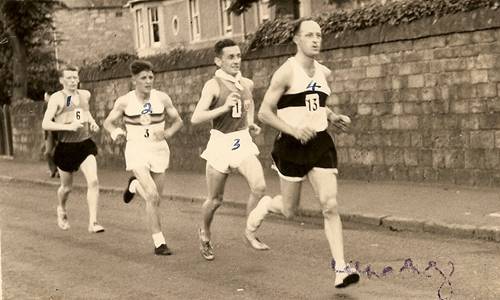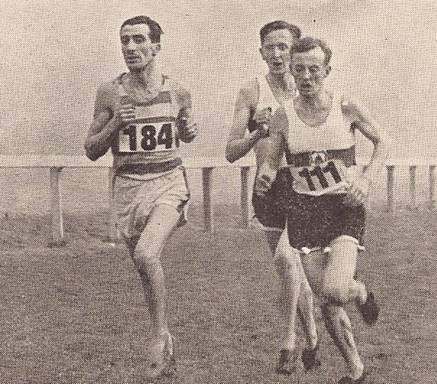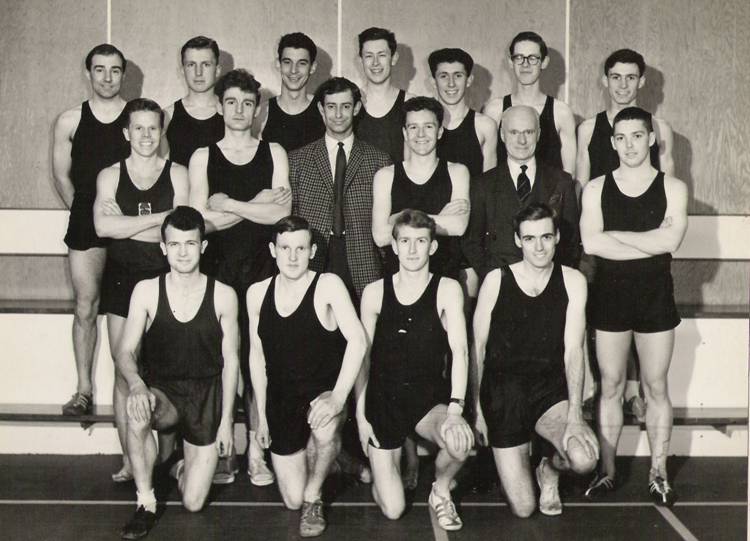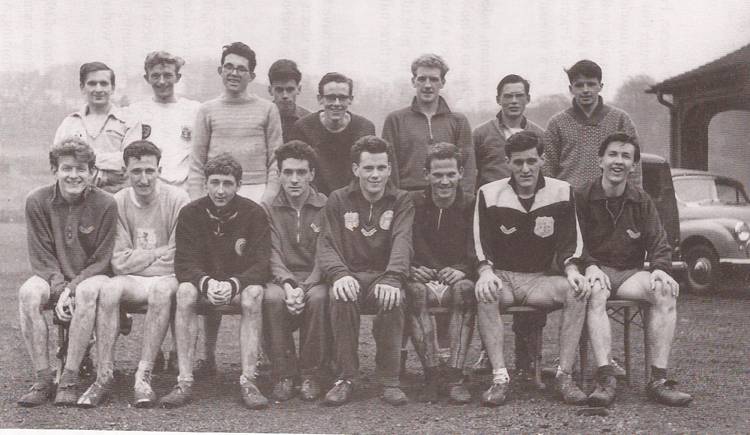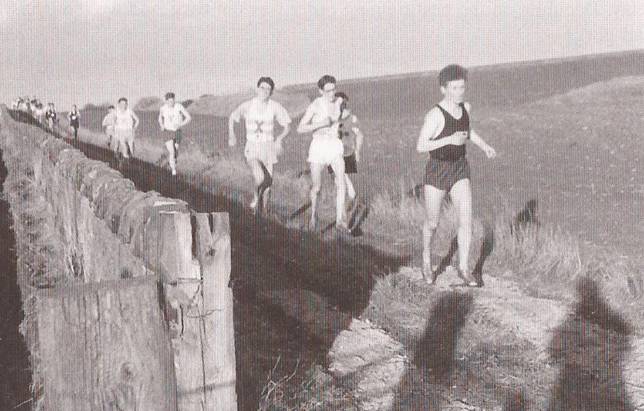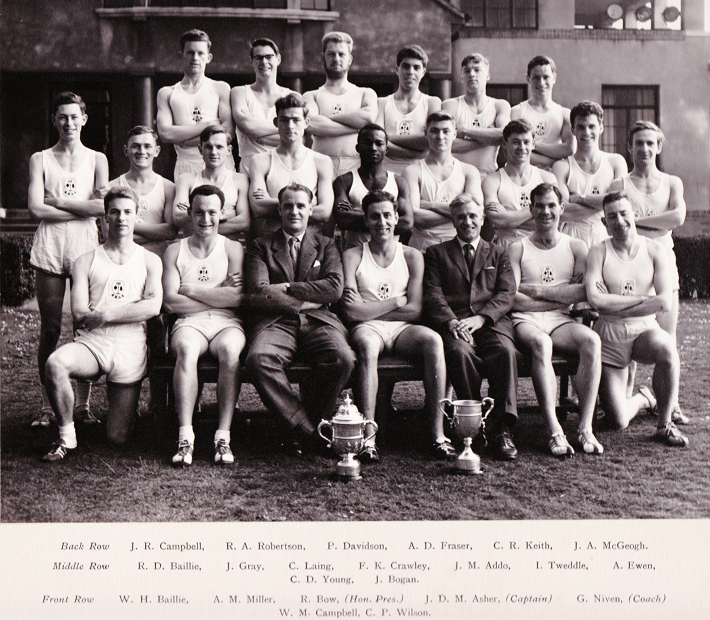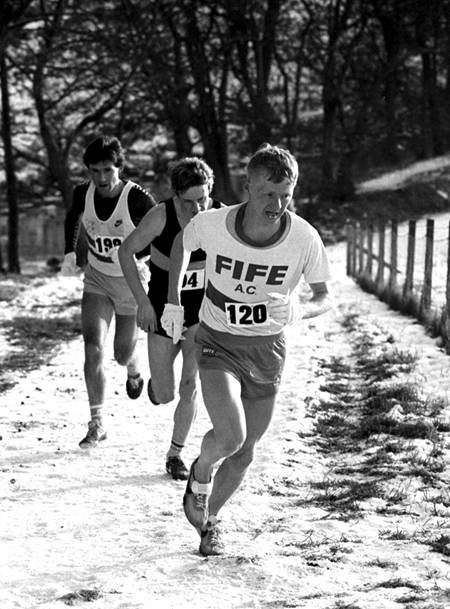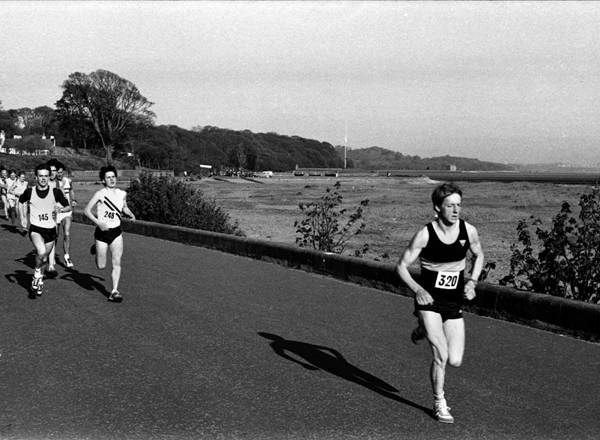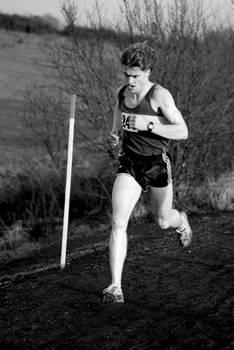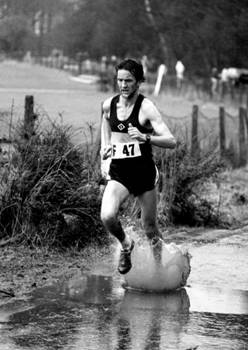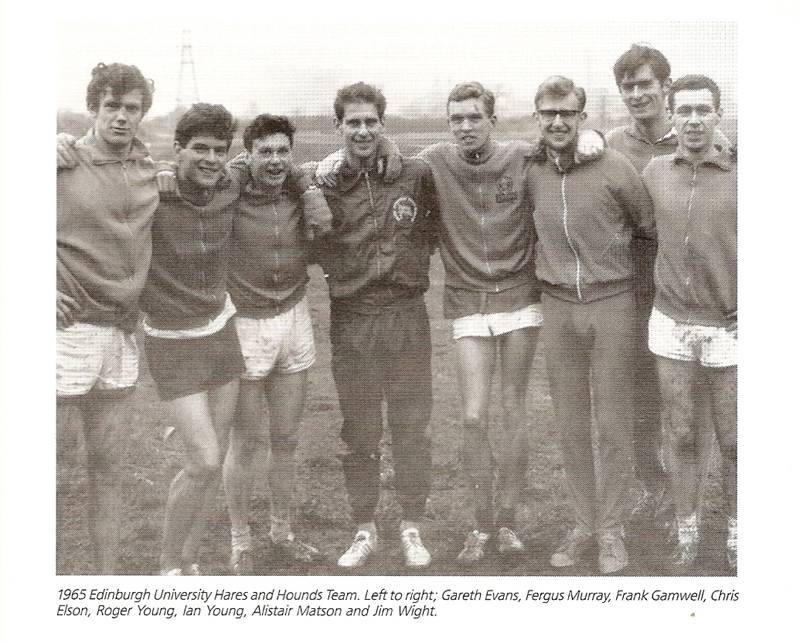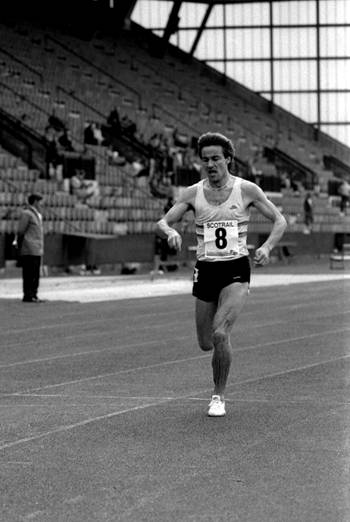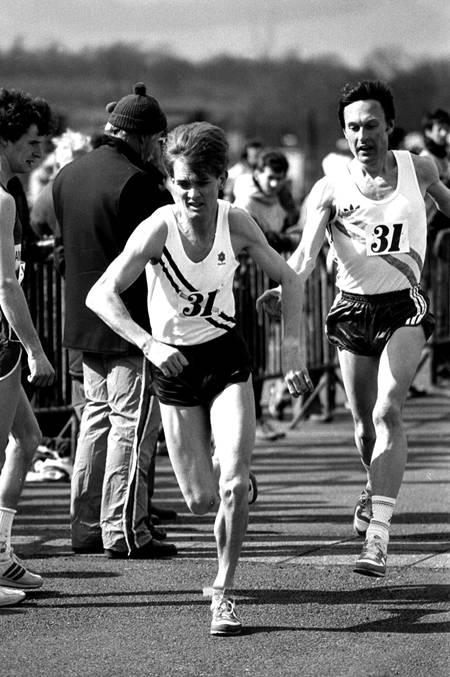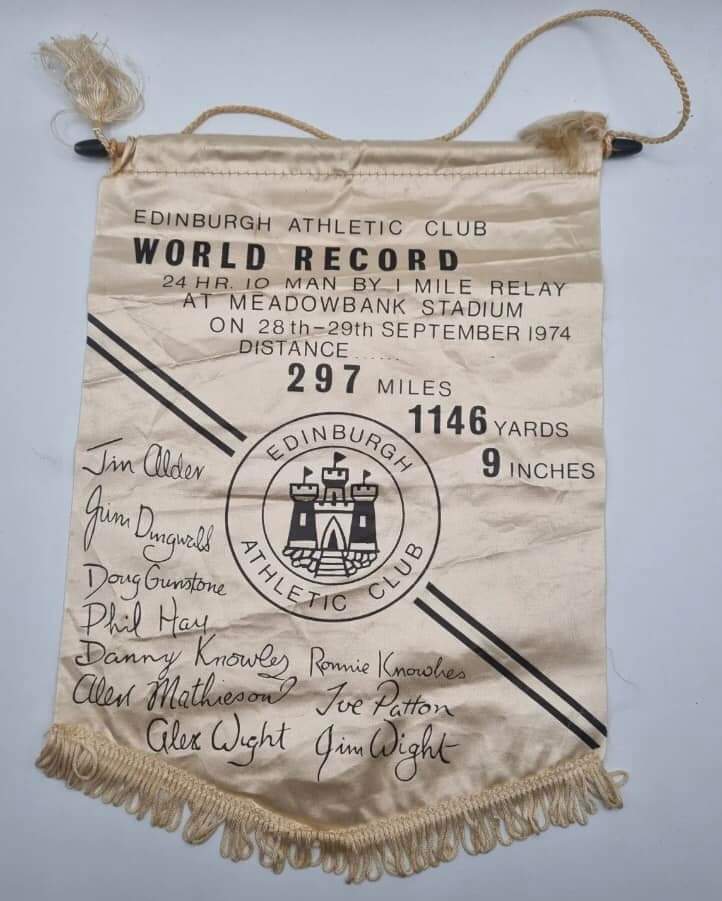Robin in the Edinburgh University 10
Robin Thomas was a talented runner who went on to be President of the SCCU and a national figure in the sport. However that is rarely mentioned when his name comes up in conversation and he is possibly better known as the spirit behind the Hunters Bog Trotters team. Such is their respect for him that in the 2011 Run and Become Open 2 Mile Race there were runners called Steve Robin Thomas Cairns, Robin Simon Thomas, Robin Ellis Thomas McKechnie, Robin Ivor Thomas Normand,Robin Eilidh Thomas Wardlaw, Robin Andrew Thomas McKechnie, Robin Deborah Thomas MacDonald, Michelle Robin Thomas Jeffrey and many others. Is it a new twist on “I’m Spartacus” or an Edinburgh version of “We’re a’ Jock Tamson’s bairns”? His friend Colin Youngson wrote this profile of the man and his career with considerable assistance from Robin himself.
Robin’s wide circle of friends and less-impressed acquaintances may consider him an endearing oddball or indeed quite outrageous but he himself claims “Not unpredictably, I would suggest that I am a “character” rather than an eccentric. Assessment of eccentricity depends upon how broad a spectrum of personalities one has met in life and to what extent one is a prisoner of conventional, unadventurous, unimaginative thinking…… i.e. Tory (metaphorically, if not literally) thinking!” In the phrasing of that suggestion, the co-founder and mainstay of Hunter’s Bogtrotters (undoubtedly the most zany and unusual Scottish running club) reveals humour, originality and a concern for longwinded verbal precision. Much of the following profile will be in his own idiosyncratic and entertaining words, since he has had the impudence, nay the temerity to criticise mine as lacking accuracy!
Robin H. C. Thomas states the following. “I was born and bred in Swansea, living there between April 1955 and August ’66. Then I became a White Settler in Edinburgh, where I lived until September 1969, before moving to Penicuik for six years. Home was a mile and a half away from (and three hundred feet lower than) Howgate. I have nostalgic memories of various Penicuik 10ks in the 1990s, seeing brown-vested runners each in turn veering out of the race and pulling across the road for a Panic Pint in the Howgate Inn (those were the days when one’s legs were still frisky enough to catch (some) people again afterwards!)
Primary education was at various schools in Swansea; with Secondary Education at George Heriot’s in Edinburgh. I started running for school cross country and athletic clubs in 1968 (eventually becoming Captain and Vice-Captain thereof respectively).
In January 1972 I suffered a mountaineering accident, in Glendoll. I was unconscious for ten days, but lived to tell the tale after spending three months in hospital. Said accident left me totally deaf in my right ear.
I matriculated as a Fresher at Edinburgh University in 1972, being instantly given the nickname of “YP” by the then EUH&H Secretary Jim Dingwall (later an outstanding Scottish and British International) when I turned up for my first Wednesday afternoon’s fartlek. At the time I was still 17 years of age and living in Penicuik and Jim cried, “Ah, you’ll have to be YP!” (YP being a group of adolescent residents of Peni, prone to killing evenings together on the streets, occasionally with a canister of aerosol paint for graffiti).” Sunday runs, unsurprisingly, were important in improving the stamina of nearly all Edinburgh distance athletes. Robin says “the Sunday training group from the Bruntisfield flat of Martin Craven (“The Crab”) went into the Pentlands, past four reservoirs (Torduff, Clubbiedean, Harlaw and Threipmuir) or sometimes seven reservoirs [aforementioned four plus Loganlea, Glencorse and Bonaly]. It was run at an amicable pace for all – often with fast runners looping back for wreckage. It was only in the mid to late 70s when Colin Youngson and Sandy Keith lived in Edinburgh that it became a burn-up along the Water of Leith valley to Balerno and back, using the formerly railway trackbed now Water of Leith walkway!” (In retrospect, I must admit partial culpability, although after Balerno, as real marathon preparation, we did occasionally come back through the reservoirs and finish with yet another lap of the Meadows to make the distance up to 25 gruelling miles.)
Robin made an impact in the November 1974 Edinburgh to Glasgow Road Relay when he was tenth fastest on Stage Two, only 14 seconds slower than Willie Sheridan, the future founder of Westerlands AC. Robin insist there is no such person – only ‘Bill Sheridan’ – but during 1971-73 I used to be in Victoria Park AC with young Willie and that is how they referred to him in Glasgow, so there, pedant! Robin represented EU in the E to G in six successive races from 1974 to 1979. One highlight was in 1977 when he was sixth fastest on the prestigious Stage Six. The following year EU finished eleventh, after Robin had gained two places on Six. Then in 1979 he tackled Stage Seven, gained three places and was second-fastest by one second to future marathon star Lindsay Robertson of EAC.
At this juncture, Robin interjected the following. “Your version tends to concentrate on racing, rather than simply on running! For me, running is an end in itself and also a means to an end (weekly racing)”.
When I was in my 20s and 30s, I tended to do Long Slow Distance and little or no speedwork. I am wary of the “no gain without pain” philosophy – in longer term it can lead to injury, disenchantment, disillusionment, becoming burnt out and retiring from the sport. How many runners, coached in their younger years, continue racing in older years. PNFA!
Runners, whatever their ability, should apply themselves wholeheartedly to the sport. Massive improvement is achievable by all, by consistent and prudent (maybe hard – which includes mere mileage – but not manic) training.
Other thoughts. 1) Racing: I have scorn for those who only race when fit; 2) Attitude: my philosophy is what can one contribute to the sport, rather what one can get out of it.”
In the 1975 Junior National CC, Robin finished 33rd but was part of the EU team that secured bronze medals. In 1976 he improved to 12th, only one second behind Graham Laing, another future marathon star.
In the 1978 Senior National CC, Robin finished a respectable 63rd which he dismisses as “dross”, mentioning that his “training was inconsistent in the later 70s and early 80s, due to having to work to support myself – night shift a speciality – while also being a (part-time) student.)” He represented EU three times in the Scottish CC Relay, and his team achieved 5th place in 1975 and 6th in 1978.
On the track, Robin recorded 32.47.4 in the 1976 East District 10,000m but must have reached half way in 15 minutes, since the eventual winner Colin Youngson remembers having to try very hard to drop him! In 1977 Robin improved to 31.30.4, which ranked 20th in Scotland. That year he was second to Ian Orton in the Scottish Universities 5000m; and third in the British Universities 10,000m at Belfast. Robin’s 5000m personal best was 14.47. (The Scotstats profile refers to him only as “Rod/Ron? Thomas”, such is Robin’s modesty and generally low profile ……..) He says “I did increasingly little track running in my later years at Uni, partly because I found long distance track running less than hedonistic. Track 10k is utterly dire compared with the 10k cross country (especially ‘real’ cross country!), road and hill-running. Also the speed work involved for track grew increasingly unpalatable as I grew older – preferring addiction to the narcotic of mileage.”
He showed considerable promise in road running. “In 1983 I did 2.25 in the Belfast City Marathon (having led most of the way, before being destroyed by the Big Guns who had been loitering not far behind, waiting to pounce in their own shoot-out/burn-up). This was my first actual marathon. I also ran 2.25 winning the International Silk Marathon in Cheshire – which I mistakenly thought would be flat, like the Sandbach event. The Silk race proved to be from Macclesfield and was anything but flat!” Robin also won the Edinburgh to North Berwick 21.8 miler twice, in 1984 and 1985, the latter in the good time of 1.57.24.
His LSD training background helped in longer races. In the 1977 Two Bridges 36 miles he finished 9th in 3.40.04 (recording his very first marathon time of 2.37.18 en route) and the race report states that he “won the handicap with a great run in his debut at the distance against a classy field”. Robin says “I was pleased to reach 30 miles inside three hours but then blew it! I had been catching a Royal Navy runner (name known but withheld) who’d been getting all manner of assistance from his mate in an M.G. Midget (which I thought a trifle unsporting). You’ll know how it is in ultras – patience! It can take about an hour to gain a quarter of a mile. But I caught the guy at 30 miles and was feeling okay – so I put in a burst going over the Forth Road Bridge (the Forth Bridge being for trains only) and stormed past him. Only to discover that it was a Pyrrhic victory – my legs were now wrecked, I slumped to 7 minute miles and he plodded past and away.”
Then in 1984 he was seventh in the gruelling Edinburgh to Glasgow 50 mile race, recording 5.51.53, having lost momentum after a pit-stop in Airdrie Fire Station. “I was also ‘bonking’ (i.e. low blood sugar) for 35 miles! There was no energy drink available but I did manage to grab a packet of Dextrosol – which made me feel great for all of two miles! Would have liked to have beaten 5.50. Ye Gods! My appetite and post-race thirst were utterly insatiable!”
“Lairig Ghru 28. I’m no hill-runner (shockingly bad at racing downhill) but did this event in the mid-80s, doing okay until the boulder field (wet from light rain) where I was simply unable to remain on my feet, falling umpteen times, while nimble chancers danced through without a slip.
Loch Tay 35. A late 1970s undulating training run from Firbush, looping right round Loch Tay. The ‘roadie’ who accompanied me on a pushbike (a certain Ian Orton) ended up with legs/quads more knackered than me due to the switchback trail.
My running and racing in recent decades has been plagued by recurrent injury to upper and lower parts of Achilles tendons (mainly lower calf/soleus). Occasional escapes from jail allow limited training (at funereal pace) before yet another relapse….. The sole important thing these days is being able to continue “running” – nine minute miles a price worth paying if it keeps the legs uncrocked! Appetite (greed!) and thirst, however, remain undiminished!”
Having been on school cross country and athletics committees from 1970 and EUH&H committees from 1973 onwards, Robin Thomas certainly had skills as an organiser. He was in charge of the Edinburgh University 10 miler, which involved two severely undulating laps of King’s Buildings and Braid Hills Drive. “Utilitarian prizes” were preferred to the usual unwanted coffee sets – members of the third team to finish that year each won sixteen Mars Bars!
Robin (the Race Secretary/Organiser) now denies that he ever produced a proper programme for this event. “Gestetner/Banda sheets and notices – yes! Hand-written/printed notices and comments in the Hare & Hounds logbook – certainly!” However I possess a yellowing copy of the typed up and stapled 1980 programme for the EU 10 (which cost me five new pence) and intend to quote from this. It proclaimed “the Edinburgh University Hare & Hounds 10-mile road race (8.87 Scots miles, since a Scots mile is approximately a furlong further than an English mile) has grown to become the SCCU’s biggest and most prestigious 10-mile road race. It now attracts Olympic and Commonwealth Games stars, British Internationalists, Scottish Internationalists, English Internationalists, SUSF and BUSF representatives and droves of runners of lesser ability.” (On reflection, if Don Macgregor and Fergus Murray had turned up, along with a good runner from Newcastle and a jogger or two, all of the above categories would be covered.)
Robin’s comments continued “Slugs (i.e. people who are not members of EUH&H) are invited to take part. Top prizes will be awarded to first Slug and to the first team of Slugs. As indicated above, all members of the Hare and Hounds, not being slugs, do not qualify for these prizes (we also reserve the right to disqualify EU Athletic Club and Orienteering Club runners, so that genuine fat slugs can take part and win). So, stub out your Capstan Full Strength, drain your pint of Export, and look out a pair of training shoes. You could win our Star Prizes – a keg of Export and half an ounce. Spectators will also enjoy the pie-eating contest and a refreshment session after the race.” (In 1980 I was one of the first team home (ESH). Prizes awarded to various finishers included Martini, four cans of beer, a homebrew kit and a jockstrap!)
Proof of the success of Robin’s eccentric marketing strategy came in 1981, when the fastest two runners in Scotland travelled over from the West to battle their way to a new record. Nat Muir (48.37) narrowly defeated Jim Brown (48.48) and secured the winner’s bottle of ten-year old malt whisky! However Robin comments as follows. “I would suggest that my marketing strategy was more unusual, novel, thoughtful, pragmatic, utilitarian, imaginative (and other such adjectives) as opposed to eccentric. Eccentricity depends on the proportion of boring grey conventionalists one has had the misfortune to meet in life. Bear in mind, too, that student clubs don’t have the financial means for spending much on prizes but can make prizes memorable/valued by using other parameters. As for the bottle of malt – the Hare & Hounds are a student club. They’re too young to have discovered the joys of malt! And student club funds are obviously very limited” etc ad nauseam. What a tease the man is! I know for certain that Nat and Jim turned up to joust for such a thoroughly acceptable prize, rather than the tin medals and reject tea-sets they were likely to ‘win’ in ‘normal’ events during that era.
Other major athletic endeavours for Robin Thomas included walking the Pennine Way in1976 and vast beer tours of the best pubs in Europe, USA and Peru. A real test of determination was ‘The Triple Hundred’ when he managed to run 100 miles and drink 100 pints in 100 hours. This took place on the Isle of Man in 1978. No less an athlete/drinker than World CC Champion Dave Bedford (who trained about 30 miles per day in his pomp but could only drink a wimpish 10 pints daily) was keen to offer his congratulations. Nowadays, Robin is aware that this was a dangerous venture and does “not want some youngster getting injured/knocked down trying to emulate me. Rules were: 100 consecutive hours; no runs of less than 3 miles; no lager – must be real ale – no soft drinks or shandy. And no honking!
Among less notorious events in which I have had the pleasure of taking part are the Trinity College “Gallon Ten” and the Phoenix 14.
The former was 10 x 1 mile (each two laps of the central Dublin campus) with 9×1 pint (an “Irish Gallon”) of Guinness in between in the cricket pavilion. The event eventually became something of a distraction to the cricket players in the simultaneous Dublin Uni v NUU match! I finished second in the Gallon Ten, behind Glasgow Uni’s Alistair Hunter (aka Bunter).
The latter involved the Northumberland Coastal Run (at one time, through sponsorship, known as the Phoenix 14) – a superb point-to-point beween Beadnell and Alnmouth. One year – many, many years ago – a group of Trotters were joined by a similarly-minded group of Westerlands runners in doing the race, but stopping for a pint in each of the half dozen (or so) splendid hostelries in or near villages en route.”
“I graduated in 1976 after a four-year M.A. Honours course. Student years continued thereafter mainly on a part-time basis (financed by night shift work). My reasoning was that not only would this add assorted academic courses to my CV, but I could continue running for “The Hairies” and the financial support then available from the Sports Union (for entries, travel, accommodation etc) was greater than fees for a course. Then there was the prolongation of the craic! I left EU in 1981 and spent my student swansong doing teacher-training at Queens University, Belfast. A very enjoyable year – also a reminder from my Swansea days of the cancer of a west coast climate (prolonged hours/days of light rainfall).”
In August 1980, along with Bill Blair, Ian Orton and Conrad White, formed a new club – Hunters’ Bog Trotters, which started out with ex-EU runners, but expanded to a wide range of like-minded individuals. An article he wrote in Scotland’s Runner magazine in February 1992 states “Our declared aim was combating elitism. HBT realised that a tasteful shade of bog brown was the obvious choice of club colour. A fine non-elitist colour, it was felt. Hunters’ Bog is a large area of (former) bog lying between Arthur’s Seat and Salisbury Crags in Edinburgh’s Holyrood Park, where many training runs were – and remain – centred. The word Trotters was chosen partly due to the terrain in Hunters’ Bog, partly because in Victorian times there had been a local running club (Edinburgh Harriers) known as the Bogtrotters, and partly because (to quote a founder member) “We do no athletics and harry no one, so calling ourselves athletic club or harriers would be both incorrect and pointless.”
“From the outset the HBT viewpoint has been that all Trotters are equal and the wellbeing of the D team no less important than the A team Both the elite and AND the also-rans/the hacks/the wreckage/the debris/the real runners are equally important to the wellbeing of a club. It’s all too easy to pay little attention to the running proletariat of the club (which is where potential for mass improvement lies) and ask after/focus on the A team and the good runners.
That emphasis on morale and club spirit is felt to be very important in this running club as it is believed an individual’s commitment to the sport will be stronger as a consequence. Also, it is felt that getting a lot of enjoyment and laughs out of life (and running), and placing major emphasis on the social life of the club (generally involving a great deal of real ale), is in no way inconsistent with being a dedicated runner.”
Robin comments further on the above: “The original newspaper article was published in the Edinburgh Evening News at the formation of the club. It was written by Sandy Sutherland and was headlined “New Edinburgh club – but not for the elite!” Three founding principles of HBT – apart from anti-elitism (metamorphosed over the years into non-elitism!) – NO God-Squad; NO Tories; and NO lager drinkers! This is to demonstrate from the outset that humour, morale, irreverence and banter are all-important to HBT. “
Nicknames abound amongst the Trotters: for example Stumpy, JamBo, Egg, Pieman, Nixon, Wah-Wah, Zoot, Phat Phil, Big D, Gash, Twiggy, McPosh, Daft Bob and Wallachie. “Wallachie is pronounce Vallachie – the Polish guys who arrested and detained us near their border in Bohemia couldn’t pronounce the “W” let alone “Wallace”.
Over the last 34 years, Robin has soldiered on valiantly as legendary club secretary/organiser and there is plenty of evidence that HBT remain true to the original ethos.
Almost incidentally the Trotters became Senior National CC team champions three times. In addition many classy runners have chosen to compete for the club and also represent Scotland and GB, especially in hill-running. Robin emphasises that HBT women, like the men, have become one of the numerically biggest and strongest cross country etc clubs in Scotland, having been National CC Champions in 2010 and medallists on many occasions. In addition they have won the National Trail Running Championships and the UK Hill/Fell Running Championships. “Whether races are held in Scotland, England or Wales, they keep winning! But we have plenty of other women Trotters supporting the great brown movement. Traditional Trotter women who, like Traditional Trotter men, enjoy the course for longer than the elitists. HBT women (likewise men) have consistently had the most finishers in Senior National CC in recent years.”
HBT continue to organise the Hunters Bog Trot, the Black Rock Race and the Grudge Match (a bi-annual mismatch against the ‘hated’ Westerlands club). “The Great Trotter Relay is held every year, since it is a massively popular event. Starts in Hunters Bog on the Thursday evening and finishes at some distant spot (Derby? Inverness?) around Sunday teatime (with major support throughout for and by a traditional domestic industry with high economic multiplier).” (Could this be some form of healthy energising beverage? Ed.) “Basically, when there are forty or fifty Trotters participating, there simply aren’t enough stages in the day – there has to be doubling up, quadrupling up, sextupling up (or whatever).
The “Golden Trotter” award (shield and vest) is awarded to the Trotter (preferably not an impressively talented leading light), whose contribution to the club over the last year – racing or otherwise – is seen to be the worthiest Trotter.”
Robin continues to work hard as an official. From rebel ‘poacher’ to gamekeeper! He started as a representative for EU and later HBT in the East District Committee, graduated to the SCCU committee and became the very last SCCU President in season 1992-1993. “I work as a club committee member in particular, but also on SARR&CCC East District Committee, Ed to NB Road Race and assorted other committees. Until recently I have been President of Vice on SARR&CCC.
“Rebel ‘poacher’? Neither I nor HBT have poached anybody? Very many Trotters are ex-students. Many others only started club competition after joining HBT. Those people who have defected from other clubs have done so because they wanted to.”
Robin Thomas’s running and organising career continues. He is an extremely effective and universally well-liked ‘character’ – a PFGM. “I’m now a dilapidated, post-middle-aged wreck but have been able to swallow any remaining vanity and resign myself to a race pace once seen as slow training pace (7.30s). All that matters at the end of the day is just being able to get out for a few miles!” (At long last, I find myself in total agreement. Ed.)
Several of YP’s associates have contributed anecdotes, accurate or otherwise.
Dave Wahwah Taylor remembers that “when Robin won the International Silk Marathon at Macclesfield, it was during the impecunious days of HBT (before all the plutocrats joined the club). Prizes won by members became the property of the club, and YP as a little disappointed with the suitability of his winnings for the forthcoming Xmas Raffle (especially after 42+km of endeavour) and penned the lines of that well-kent blues number ‘The Macclesfield Silk Tie Blues’!”
Ron Morrison adds “I recall Robin’s tradition of having a pint on the way out of Haddington in the 5 miler and doing the same on the way back. One year in the early 1980s, he and Bill Sheridan ran 8 alternate legs (4 each) of the Laggan Valley relay to finish 5th team. Robin was President of the SCCU for one week only. He was elected at the AGM in 1992 with a remit of voting for the establishment of the SAF one week later (when the SCCU disbanded). Quite fitting really that it should be Robin. I also remember him eating a fish supper just before the start of the Cupar 5. Indeed he let the start go until he finished the fish supper.”
Ron sent a second email on the topic. “What did ‘YP’ mean? ‘Young Pretender’ was one interpretation I heard! When I was trying to write a definition of a Club in order to set up the new SAF in the early 90s, I floated the idea that a Club was one that had a Constitution and its members paid fees to the Club. Robin told me that this would not do as HBT had tried that and given it up as the treasurer had gone to the pub with the subs and drunk the lot with the members who were present.”
Ian Kiltie emailed many tales. “Robin’s trip with the Guv’nor to see the 1974 European Championships in Rome. Robin went AWOL at Heathrow and missed the flight, which gave Jim a couple of solo days visiting Rome’s churches while Robin renegotiated the flights. The Boston Marathon with Iain Wallace: Robin ended up running the last (first) five miles to the start, against the flow of runners who had already started – ever the purist, he never thought of just joining in.”
“The night Robin met Daley Thompson. Robin had to head off to his holiday toilet cleaning job, but Ian Orton and I were treated to hearing the young Daley (this was ’78) singing “She stood on the bridge at midnight ….” Since Robin had introduced the future Olympic gold medallist to his (Robin’s) infamous songbook.”
“The time that Frank Dick read Robin’s training diary. “What is THAT word? Look, there it is again!”
“The time the fire brigade had to axe their way into his Dreghorn flat because he had left tinned haggis cooking and the neighbours spotted the smoke.”
“Belfast stories. On one of his first nights at Queens, Robin fell in with some types who (naturally for that part of the world) asked which team he supported. Robin, aware of the subtext, replied ‘Meadowbank Thistle’. “No, What TEAM do you support?” Robin had to rely on his knowledge of Irish accents to save the day.”
“Also from the Belfast Days, the Red Bill story. Robin had gone to some left-wing political meetings in Belfast and had been asking probing questions on the state of the plans for the revolution. The Belfast Socialists had become suspicious and desired finding out more about this peculiar Welshman from Edinburgh before kneecapping him as a suspected special branch agent. So they put a call into the Scottish HQ of the Workers Party. It just so happened that Bill Gray was there when the revolutionary speaking from Belfast on the phone asked around “Does anyone know a Robin Thomas?” Bill replied “The Robin Thomas I know is just a daft runner from Edinburgh.” Once again, he lived to see another day.”
“We were also in Belfast the day Virginia Wade won Wimbledon in 1977. Robin spent the afternoon watching the tennis and getting through a case of Guinness. However he had the BUSF 10,000m in the evening and some were taken aback by his preparations. It was very humid and the Guinness must have helped with his hydration because with 9900m gone he was placed 3rd. Then, with just the straight to go, he stopped – he may have had a digestive malfunction, but the momentum was gone and he was overtaken, as he jogged in over the last 100m.”
“The time on his travels (can’t remember whether it was Oz, NZ or USA) when he entered some big mass participation race and discovered in the newspaper next day that he had been given the prize for the first woman (the organisers had him down as Robyn Thomas)!”
“Robin’s provisional driving licence (luckily the world didn’t see anything come of that) where on the Mr/Miss/Mrs/Dr/Other box on the application form, Robin had written Professor – so there was a 17-year-old with a provisional driving licence for Prof. Robin Thomas.”
I can add one more. In the Spring of 1978, before some championship race or other, I was in the dressing room when I was pleased to see my good friend Robin enter. His was a double mission: a) to sell ‘red men’ (i.e. cans of McEwan’s Export) to thirsty athletes; and b) to raise money for charity. He explained, in his verbose, apparently sincere and idiosyncratic manner that he was committed very soon to a sponsored event which would entail running many miles in a brief number of days and also imbibing a great deal of real ale. I was in a quandary. Part of me wished to help YP avoid bankruptcy but part of me did not wish him to endanger his health. Decision time: I agreed to sponsor him for a certain amount. “Good man,” he replied, gratefully, “If you can pay up right now, I would appreciate your generosity, because I actually succeeded in this task three weeks ago.” That Charitable Challenge was, of course, The Triple Hundred!
Ian Kiltie supplies the final anecdote. “I only saw the late, great International athlete/beer drinker Andy Holden (of Tipton Harriers) come second-best at drinking once…. At my fortieth birthday (2 decades ago!) I held a 4×1 mile relay with a pint to be downed after each leg. We ended up with two of running’s greatest beer drinkers coming in side-by-side on the last leg – Andy Holden and Robin Thomas! Andy was so confident of beating Robin on the pint that his tactic was going to be to wait until Robin had to gasp for air and then neck it in one, so he paused – bad mistake! Robin tells me that he had spent the last couple of hundred metres of his run trying to hyperventilate, so he wouldn’t need to take any gulps of air, and promptly downed his pint in one, very fast. Andy was impressed. That was one of the few occasions he was beaten on a pint.”
And there this saga has to end. We seem to have finished on humorous boozy tales but make no mistake, Robin “YP” Thomas has given an incredible amount to his chosen sport of running (indeed to Scottish Athletics) as well as entertaining (for several decades) so many of his fortunate friends.
